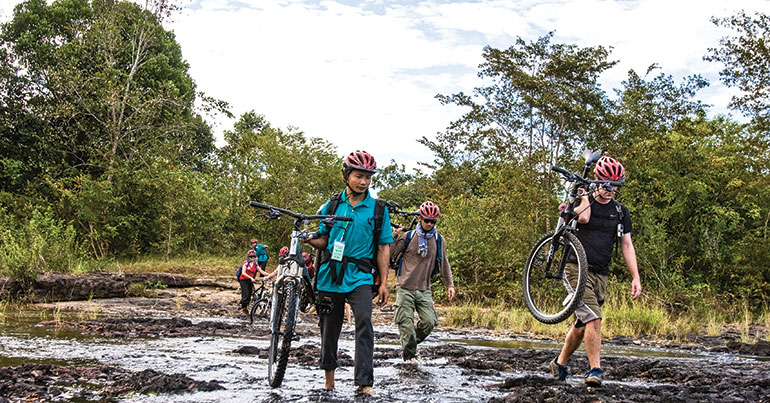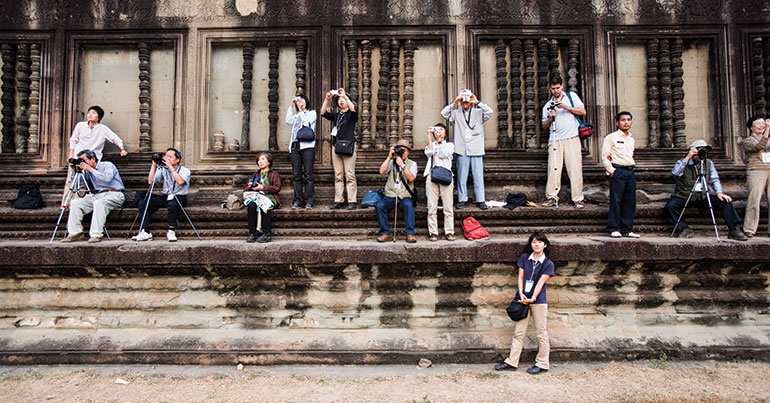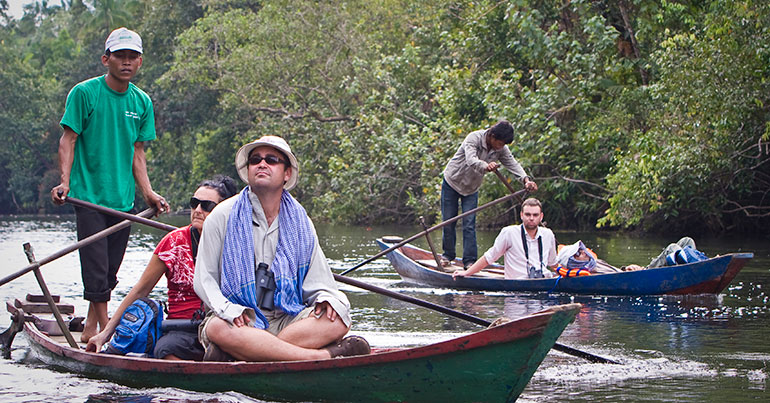From taking in the intricate carvings that make up the world’s longest continuous bas-relief to stepping back almost a thousand years and strolling through hallways once reserved for royalty, visiting the majestic Angkor Wat creates a tapestry of unforgettable memories.
Equal parts awe-inspiring and beguiling, the ancient remnants of the Khmer Empire are undoubtedly the crown jewels of the country’s flourishing tourism industry, a sector that directly contributed $2.4 billion to the country’s economy in 2016, according to a recent report by the World Travel and Tourism Council. But while that figure is expected to rise by 6.5% per annum until 2027, analysts have warned that the industry will struggle in the long-term unless it diversifies its product offering – a call-to-arms that both public and private sectors have begun to answer.
In the first ten months of 2017 alone, the Ministry of Tourism says the country welcomed nearly five million tourists, a 10% increase in foreign visitors from the same period in 2016.
In the eyes of Harry Greig, area marketing manager at Sofitel Phnom Penh Phokeethra, a yearning for authentic experiences is one of the main factors driving record numbers of tourists to visit the country.
“Cambodia is blessed with stunning landscapes, impressive world-heritage sites and authentic hospitality,” he said. “In an era in which travellers are looking for more genuine experiences, the country offers a dynamic array of destinations that are not widely known to the rest of the world.”

Underpinning the country’s healthy tourism growth is the government’s ‘China Ready’ strategy, which aims to attract two million Chinese tourists annually by 2020, part of a wider ongoing strategy to deepen both economic and political ties with Beijing. Released in May 2016, the ‘China Ready’ programme’s main objective is to maximise the potential of the rapid rise in China’s outbound tourism by encouraging businesses in Cambodia’s tourism industry to hire Mandarin-speaking staff, translate menus and promotional posters, facilitate payment in yuan and offer ecotourism options.
If recent government statistics are anything to go by, the policies seem to be working. In 2016, China overtook Vietnam as the number one source of visitors to Cambodia and, in 2017, visitors from the superpower topped one million.
According to Greig, Sofitel witnessed a 51% increase in Chinese clientele and a 300% increase in business groups originating from mainland China in 2017 – an influx that he said the hotel, which has numerous Mandarin speakers on its staff as well as Chinese TV channels, newspapers and magazines in its rooms, was well positioned to accommodate.
The capital’s leading hotels aren’t alone in rolling out the red carpet for their Chinese guests. Cambodia Airports, the company that has a concession to operate the country’s three international airports until 2040, has installed digital signs across its Phnom Penh and Siem Reap sites that display passenger information in Mandarin. It has also worked with the independently run, member-driven Cambodia Tourism Federation to produce information pamphlets, maps and guidebooks in Mandarin, which it hands out free of charge at an information counter located outside Phnom Penh International Airport’s arrivals gate.

But while Cambodia Airports CEO Éric Delobel acknowledged the importance of Chinese tourists to the country’s economy, he warned against the industry putting all its eggs in one basket.
“The key point is diversification. We have to make sure that we simultaneously attract and welcome tourists from other countries,” he said. “India is one of our main targets. We are engaging tourism stakeholders from India – travel agencies, airlines and tourism operators – first, to understand the market, because it is a huge market but also a very specific one, and then, to find a relevant partner and open one route with an airline.”
Australia, Indonesia, Japan, the Philippines and Russia are other markets high on the company’s list of expansion priorities, added Delobel.
Efforts to diversify the sources of Cambodia’s inbound tourism have been mirrored by attempts to promote tourist destinations other than Angkor Wat – a strategy welcomed by those concerned about the preservation of the world heritage site, and one that World Bank economists said in 2014 was integral to the industry’s long-term success.
“We need to diversify our tourism products for people to come again and again. This includes creating more eco-tourism – 80% of tourists go to Thailand for the coastal regions, while only 1.4% come to Cambodia for the coastal regions,” Sodeth Ly, a World Bank country economist, told the Cambodia Daily newspaper just days after the international financial institution released a 2014 report that revealed construction had overtaken tourism and agriculture to become the country’s second largest sector.

Fast forward four years and Cambodia certainly appears to have heeded the World Bank’s advice.
While a recent influx of private investment has begun to transform the coastal city of Sihanoukville and its neighbouring islands into a viable beach destination replete with luxury resorts, casinos and national parks, the government has tried to promote provincial alternatives such as Battambang, Kratie and Kampot by formally requesting that Unesco consider awarding heritage status to the three cities, all of which are home to fading colonial architecture.
In a further attempt to diversify the tourism sector, as well as generate revenue for local communities, the government has also said that it will focus more on promoting the country’s fledging eco-tourism industry. To this end, in 2017, tourism minister Thong Khon set up an inter-ministerial task force focused specifically on developing and managing community-based eco-tourism locations such as Prek Toal bird sanctuary and Kulen mountain.
Located in a flooded forest between Battambang and Siem Reap, Prek Toal has been heralded by conservationists as a particularly successful collaboration between government and civil society. After rampant egg poaching caused the local population of birds to dip under a thousand around the turn of the new millennium, the Ministry of Environment partnered with the Wildlife Conservation Society to set up an eco-tourism project that pays locals to protect the birds and their habitat instead of hunting and cutting down the forest. Today, the number of birds in what is Southeast Asia’s largest water bird colony exceeds 100,000. The government’s efforts have certainly captured the attention of Carrol Sahaidak-Beaver, director of the Cambodia Tourism Federation. The way she sees it, dramatic improvements in the country’s infrastructure over the past five years have played a crucial role in connecting tourists to a wider range of cultural sites and destinations, which has boosted local economies and inspired more tourists to visit the Kingdom.
“Cambodia will continue to expand its destination experiences as more and more tourism products are refined and developed. I say refined as there are so many out there that [just need better infrastructure],” she said. “A good example is Banteay Chhmar [a temple 20km east of the Thai border]. It’s a fabulous experience that more tourists are now travelling to see as the road has been rehabilitated. Cambodia is becoming known not simply for Angkor Wat.”


